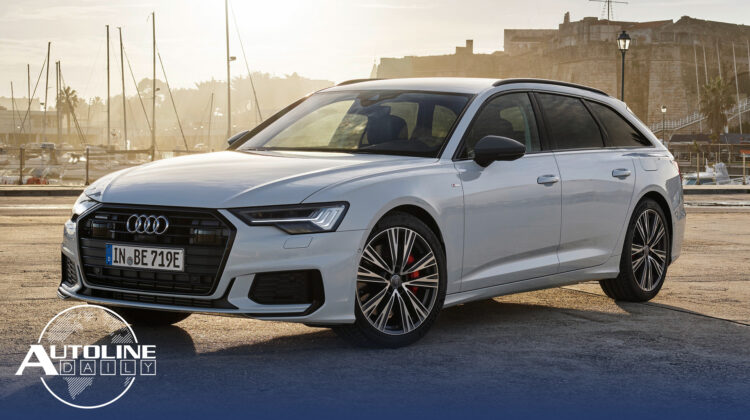
Listen to “AD #2824 – UAW Could Feel Pressure to Open Plants; Traffic Maps Show Huge Drops; New Audi A6 Wagon Plug-In” on Spreaker.
Follow us on social media:
Runtime: 9:33
0:07 European Production Slowly Picking Up
0:38 Michelin Criticized for Continued Tire Production
1:15 Daimler Sales Turning Around in China
1:38 Ford Skeleton Crews Prep for Restart
2:04 Automakers Ready to Restart Production in the U.S.
2:42 FAW Will Make Sports Cars with U.S. Company
3:22 Traffic Maps Show Huge Drops
4:23 Porsche Helping Kids to Pass Time
4:50 Daimler Converts Bus Into Giant Ambulance
5:23 New Audi A6 Wagon Plug-In Hybrid
6:18 The Future of EV Batteries
Visit our sponsor to thank them for their support of Autoline Daily: Bridgestone.
This is Autoline Daily, the show dedicated to enthusiasts of the global automotive industry.
EUROPEAN PRODUCTION SLOWLY PICKING UP
We start in Europe where automakers and suppliers are starting to get production going again but are running their assembly lines a lot slower. Renault, PSA and FCA are restarting most operations, and Volkswagen called back 8,000 workers to its main plant in Wolfsburg, Germany. Production is running slow because the supply chains are slowly ramping up. But it’s also because sales are way down and they don’t want to end up with a pile of unsold inventory.
MICHELIN CRITICIZED FOR CONTINUED TIRE PRODUCTION
In France, Michelin never stopped making tires for essential vehicles. That includes such as ambulances, farm equipment and heavy trucks. Michelin is getting a lot of resistance from French unions, which accuse it of being more worried about the price of its stock than in its workers’ safety. But Michelin points to the lessons it learned in China. It restarted production there in February using masks, temperature checks, social distancing and disinfecting work stations. None of its 8,000 Chinese employees caught the virus since coming back to work.
DAIMLER SALES COMING AROUND IN CHINA
Daimler says sales are starting to stabilize in China now that the lockdowns ended. It sold around 50,000 vehicles in March, which isn’t too far off its average monthly total from last year. In 2019, Daimler sold nearly 700,000 vehicles in China, which accounted for nearly a third of its sales.
FORD SKELETON CREW PREPS FOR RESTART
Now to the U.S., where Ford is bringing in skeleton crews to start prep work to reopen its plants, perhaps next month. The crews are salary and hourly who volunteered but are paid. And they will go through a strict safety regimen to protect them from the virus. Even so, the UAW is very concerned. Twenty five UAW workers have died from Covid-19 since the end of March.
AUTOMAKERS READY TO START PRODUCTION IN THE U.S.
Ford and GM say their plants are closed indefinitely, but Roland Berger reports that next week Volkswagen, Hyundai, Honda, Toyota, Subaru, BMW and FCA are scheduled to resume production in the U.S. And that will put enormous pressure on GM, Ford and the UAW to not be left behind.
FAW TO MAKE SPORTS CARS WITH U.S. COMPANY
We’ve always admired the Honqi luxury sedan with its retro look. Honqi is the brand that’s owned by Chinese automaker FAW, which has been around since 1958 and is known for large luxury sedans, used by top government officials. Now Honqi is joining forces with Silk EV to make sports cars. Silk EV is a U.S.-based automotive engineering and design company that will invest $1.41 billion in China to make the vehicles. FAW hopes to double Hongqi’s sales this year to 200,000 units and reach 1 million vehicles sold by the end of the decade.
TRAFFIC MAPS SHOW STARTLING REDUCTION
Last week we reported how pollution levels around the world are going down. No surprise there, very few people are driving. But how many fewer drivers did it take to reach those low levels of pollution? TomTom, the nav company, uses data from its devices to create traffic maps. Here’s a typical one from the city of Milan before the coronavirus outbreak. The darker the line, the more traffic there is. And red is where it’s the highest. Now here’s Milan on April 6th. TomTom calculates that traffic in the city is down about 85% and other major cities are seeing similar drops in traffic. It was down over 84% in Paris and San Francisco saw traffic go down about 75%. And TomTom says it looks like people are sticking to social distancing orders. Even though the weather was nice in the UK for the Easter holiday, TomTom did not see a big increase in traffic flow.
PORSCHE HELPING KIDS TO PASS TIME
And many of those people that aren’t driving are parents, who are looking for news ways to help kids pass the time. Porsche set up a new website, called porsche4kids.com that has lots of activities to do. There’s everything from word find to memory games and comic books to virtual museum tours. What we like is it’s free and there’s plenty to do without the kids needing their face planted to the screen.
DAIMLER MAKES GIANT BUS AMBULANCE
This just may be one of the biggest ambulances in the world. Daimler Bus converted a Citaro inner-city bus to transport COVID-19 patients. It took three weeks to make, has four intensive care beds with ventilators, monitors, various other devices and even lights and sirens. A German hospital is going to supply the medical staff and a public utility company is going to provide the drivers and maintenance personnel. The German Red Cross will use the giant ambulance for the next six months.
AUDI A6 WAGON PLUG-IN
Audi introduced the plug-in hybrid version of the A6 station wagon. Officially called the A6 Avant TFSI e quattro, boy what a mouth full, it’s powered by a 2.0L gasoline engine that’s mated to a seven speed DCT. It’s 14.1 kWh lithium-ion battery provides about 32 miles of electric only range based on the WLTP cycle. Some of its standard features include the Audi virtual cockpit, Matrix LED headlights as well as sport suspension and sport seats. The A6 PHEV wagon carries a starting price in Europe of nearly 72,000 euros which is a little over $78,000.
THE FUTURE OF EV BATTERIES
The cost of batteries for electric cars is coming down every year. But when will they reach a cost parity with ICE cars? On Autoline After Hours last week, Bob Galyen, who recently retired as the CEO of CATL which is China’s largest battery manufacturer, says it’s not as easy as quoting some dollar per kilowatt hour number. He says there are a lot more factors than that. Take a look.
Gary Vasilash
“Isn’t the issue of cost equity (between EVs and ICS) based on manufacturing cost, not on usage cost?”
Bob Galyen
“The manufacturing costs are coming down on an annualized basis. It is clear that the cost of batteries is coming down. But at this point it’s almost irrelevant what the cost of oil is for people who want to buy cars. Because depending on where you are, let’s say you’re in China, you’re going to buy it (an EV) because you want to drive it into Beijing or Shanghai every day. Because if you’re driving a petroleum based car, you’re only going to drive into the city every other day because if your license plate ends in an ever number or an odd number you drive on alternative days. Otherwise you have to take mass transit. But if you’re in Europe it might be a different story because the cost of electricity in some areas is extraordinarily high. So there’s an entirely different reason why some might want an electric car. It almost seems irrelevant, the cost between oil and electricity, to those who own electric cars, at least the ones I talk to.”
Gary Vasilash
“So what would be cost parity. Would it be $100 per kilowatt hour that would make it equal to the cost of an ICE?”
Bob Galyen
“Well that $100 per kilowatt hour, remember, came out of some talk in Washington DC some years ago. I don’t think there’s anything magical about $100/kWh. The marketplace is flexible. Things go up and down. I remember when I was president of Magna E-Car, in one fell swoop, within one month, the cost parity between the Euro and the Japanese Yen cost me a 25% cost penalty. So for every battery pack I was shipping to an unnamed car company, I would also ship a $2,000 bill along with it. So there’s so many variables within the marketplace that people don’t even consider. They always want to pound on this dollar per kilowatt hour number when in fact that’s like a rubber ruler. It depends on how you stretch it with respect to the price of oil; the cost of the raw materials that go into the battery. Some people may think i have a bit of radical thinking in that regard, but during my 43 years in batteries that’s the way it’s always been.”
If you want to learn a lot about EV batteries, check out that entire show on our website or YouTube channel. It is jam packed with information about batteries.
And with that we wrap up today’s report. Thanks for watching.
Thanks to our partner for embedding Autoline Daily on its website: WardsAuto.com

John McElroy is an influential thought leader in the automotive industry. He is a journalist, lecturer, commentator and entrepreneur. He created “Autoline Daily,” the first industry webcast of industry news and analysis.





